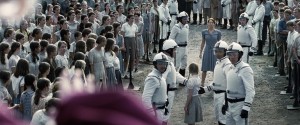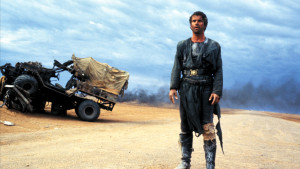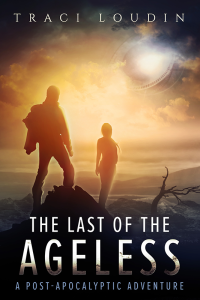Much has been written that crosses the boundaries between dystopian and post-apocalyptic fiction. To me, the biggest distinction is the conflict. Remember back to your high school English literature days… Remember when the teacher would ask you to identify whether a story was “man vs. man” or “man vs. nature”?
Dystopian fiction tends to focus on character vs. society, whereas post-apoc often leans toward character vs. nature or character vs. character.
 Dystopia
Dystopia
Common Themes in Dystopian Stories
- what it means to be human
- corruption
- abuse of power
- authority
- injustice
- class system
- freedom and the price of freedom
- oppression
Examples of Dystopias
These examples go from the more top-of-mind to less so. I also included a quick summary, though it’s hard to summarize such great and classic books!
- The Hunger Games: A corrupt state controls the populace through fear and annual Hunger Games
- The Giver: Tightly regimented society with only a few who remember the old ways
- 1984: Classic police state and an oppressive government
- Brave New World: Totalitarian state creates caste system and drugs to control the populace
- Fahrenheit 451: Totalitarian state controls populace through censorship (books)
- Little Brother: Controlling government misuses technology to maintain power
- The Handmaid’s Tale: New republic controls procreation and women’s access to knowledge
- V for Vendetta: Authoritarian government controls news broadcasts
- Maze Runner: Kids are put into a maze and forced to find a way out, similar to Hunger Games
- Matched: Each person is paired with their “ideal mate”
 Post-Apocalypse
Post-Apocalypse
Common Themes in Post-Apocalyptic Stories
Certainly, many of the above dystopian novels can be deemed “post-apocalyptic” as they’re literally “after the apocalypse,” but books that sit solidly in the PA genre generally use these themes:
- what it means to be human
- survival
- civility
- rebuilding civilization
- starting over
- learning from our mistakes
Examples of the Post-Apocalypse
- Mad Max: After the end of the world, people struggle to survive
- The Walking Dead: Zombies show up and most people turn into the worst versions of themselves
- The Road: A man and boy struggle to survive vs. cannibals
- The Stand: People struggle to reorganize into societies and find meaning in this new world
- World War Z: Eyewitness accounts of the zombie war
- Seveneves: 5,000 years after the apocalypse, the survivors return to Earth
- Station Eleven: A troupe of actors and musicians keep the remnants of art alive
- One Second After: A patriot survives the end of the world and struggles to keep his daughters safe
- Wool: The survivors of the apocalypse confine themselves to old silos
What’s Next?
 As with most things fantasy and science fictional, it’s not always easy to draw a hard line between dystopian fiction and post-apocalyptic fiction. My next post explores what happens when one is the subgenre of the other. Certainly, many of the above dystopian novels can be deemed “post-apocalyptic” as they’re literally “after the apocalypse,” but books that sit solidly in the PA genre generally follow a few themes. While you’re waiting, check out this awesome dystopian vs. post-apocalyptic flowchart. (Though I don’t agree with everything on it!)
As with most things fantasy and science fictional, it’s not always easy to draw a hard line between dystopian fiction and post-apocalyptic fiction. My next post explores what happens when one is the subgenre of the other. Certainly, many of the above dystopian novels can be deemed “post-apocalyptic” as they’re literally “after the apocalypse,” but books that sit solidly in the PA genre generally follow a few themes. While you’re waiting, check out this awesome dystopian vs. post-apocalyptic flowchart. (Though I don’t agree with everything on it!)
Post-Apocalyptic Novel
Right now, you can get my post-apocalyptic adventure novel, The Last of the Ageless, for $2.99.
[button url=”https://www.traciloudin.com/book/the-last-of-the-ageless”]See More[/button]
Thanks for reading this post. Let me know how you differentiate dystopia from post-apocalypse in the comments.
Comments
8 responses to “Dystopian vs. Apocalyptic Fiction: What’s the difference?”
I can think of examples of dystopic societies which have their genesis in an apocalypic event. “The Stand” is a good example where the dystopia in Las Vegas was a result of the apocalypse, which was itself brought about by the agents of the dystopia. Round and round we go.
Another example which comes to mind is the Change series of books by Sterling – After the apocalypse, opportunistic authoritarians create a dystopia in Portland.
Is this what you mean by blurring the lines?
Thanks for stopping by, Andrea! Yes, those are blurry lines, for sure. My next post will talk about how dystopia can sometimes by a sub-genre of post-apoc.
I know this post is from 2015, but I write about a Post Dystopian world. These are the survivors of the disease, crime and man against man times of post apcolyptic and dystopia. So, mine dont fit in either category. My novels are post dystopian.
That is interesting, Tamalyn. Happy to see a fellow author stop by. 🙂 Thanks for commenting!
[…] Definitely not. In fact, I have a whole blog post dedicated to the differences between these genres over here. […]
[…] Dystopian vs. Apocalyptic Fiction: What’s the difference? […]
[…] Dystopian vs. Apocalyptic Fiction: What’s the difference? […]
[…] Dystopian vs. Apocalyptic Fiction: What’s the difference? […]